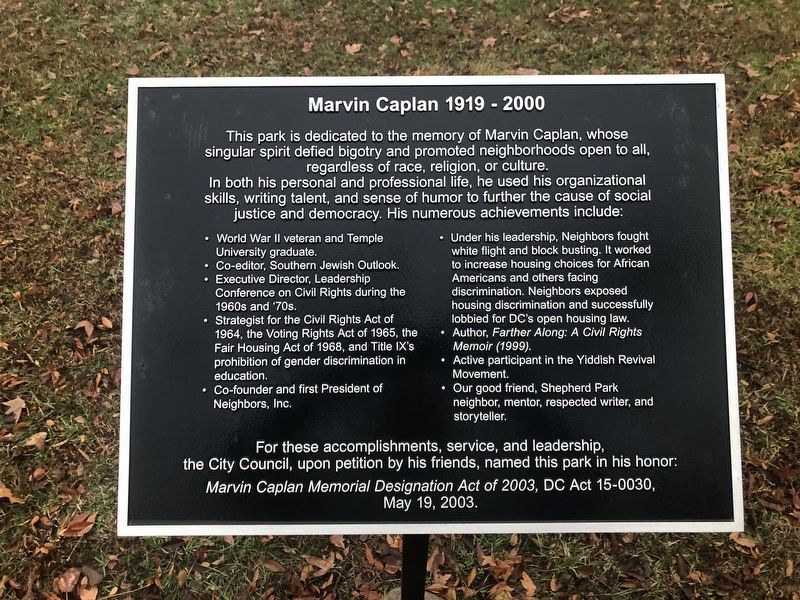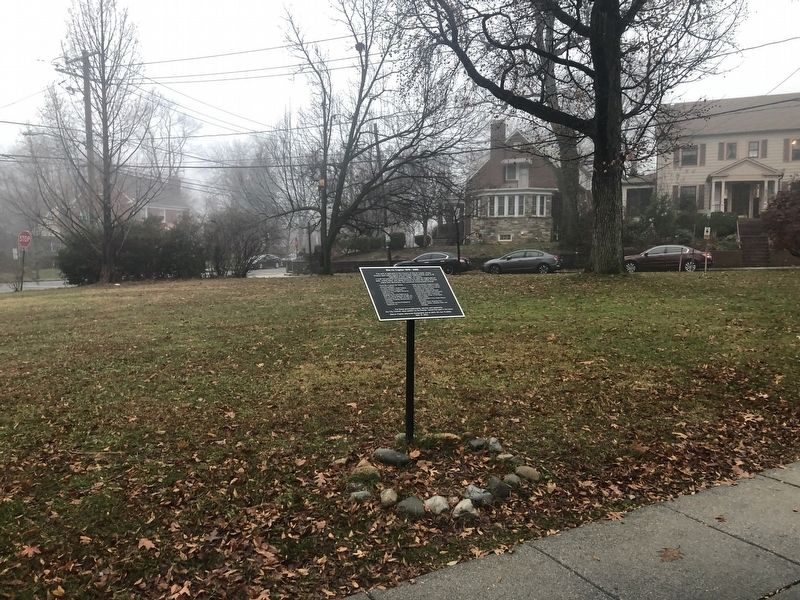Shepherd Park in Northwest Washington in Washington, District of Columbia — The American Northeast (Mid-Atlantic)
Marvin Caplan 1919 - 2000
This park is dedicated to the memory of Marvin Caplan, whose singular spirit defied bigotry and promoted neighborhoods open to all, regardless of race, religion, or culture. In both his personal and professional life, he used his organizational skills, writing talent, and sense of humor to further the cause of social justice and democracy. His numerous achievements include:
• World War II veteran and Temple University graduate.
• Co-editor, Southern Jewish Outlook.
• Executive Director, Leadership Conference on Civil Rights during the 1960s and '70s.
• Strategist for the Civil Rights Act of 1964, the Voting Rights Act of 1965, the Fair Housing Act of 1968, and Title IX's prohibition of gender discrimination in education.
• Co-founder and first President of Neighbors, Inc.
• Under his leadership, Neighbors fought white flight and block busting. It worked to increase housing choices for African Americans and others facing discrimination. Neighbors exposed housing discrimination and successfully lobbied for DC's open housing law.
• Author, Farther Along: A Civil Rights Memoir (1999).
• Active participant in the Yiddish Revival Movement.
• Our good friend, Shepherd Park neighbor, mentor, respected writer, and storyteller.
For these accomplishments, service, and leadership, the City Council, upon petition by his friends, named this park in his honor:
Erected by Marker erected by neighborhood and Caplan family donations.
Topics. This historical marker is listed in these topic lists: African Americans • Arts, Letters, Music • Churches & Religion • Civil Rights.
Location. 38° 58.839′ N, 77° 1.804′ W. Marker is in Northwest Washington in Washington, District of Columbia. It is in Shepherd Park. Marker is on Alaska Avenue Northwest just north of Holly and 13th Streets Northwest, on the right when traveling north. Touch for map. Marker is at or near this postal address: 7500 Holly St NW, Washington DC 20012, United States of America. Touch for directions.
Other nearby markers. At least 8 other markers are within walking distance of this marker. Sam Gilliam (approx. 0.2 miles away); To Count So High (Beacon), 2017 (approx. 0.3 miles away); Shepherd Park Christian Church Stormwater Features (approx. 0.4 miles away); William L. Chaplin Arrested! (approx. 0.4 miles away in Maryland); The Civil War in Silver Spring (approx. 0.4 miles away in Maryland); Original Federal Boundary Stone, District of Columbia, Northeast 1 (approx. 0.4 miles away
Regarding Marvin Caplan 1919 - 2000. Washington Post Archives: Article
D.C. Integrationist Marvin Caplan Dies At 80; Civil Rights Champion Founded Group To Fight Racism In City Real Estate Market
Adam Bernstein
Washington Post Staff Writer
Friday, January 14, 2000; Page B07
Marvin H. Caplan, 80, a founder of Neighbors Inc., whose mission was keeping a Northwest Washington community integrated in the 1950s and 1960s to show middle-class blacks and whites they could live together, died of lung cancer Jan. 12 at his home in Washington.
In the 1950s, several Washington neighborhoods saw a reversal of what had been majority-white home ownership. Using a technique called "blockbusting," real estate brokers would exploit the fear of middle-class white residents by buying their properties below cost and reselling to blacks at a large profit.
Mr. Caplan, then a professional writer and later an AFL-CIO lobbyist and executive director of the Leadership Conference on Civil Rights, moved with his family into Manor Park in 1957. Finding a local citizens group unreceptive to removing racial restriction clauses from leases, he and about 50 other residents of both races formed Neighbors Inc. the following June to combat the racism into which those real estate speculators tapped. Ironically, the brokers' defense was that Neighbors promoted racism by discouraging black families from moving into the area in question, roughly east of Rock Creek Park, west of Blair Road, north of Ingraham Road and south of the District line.
Neighbors Inc. fought grim -- and in its estimation misleading -- statistics about District crime, property values and education levels. Members wanted to show that integration does not necessarily mean a transition from a middle-class enclave to a slum; Mr. Caplan hoped that no matter who lived there, the local character would remain middle-class.
"Some [brokers] use unethical arguments, rumors and misrepresentation of facts, as well as blatant appeals to racial prejudice in a way to evoke fear and unrest," Mr. Caplan told The Washington Post in 1961.
A year before the newspaper quoted him, Mr. Caplan wrote an article for Atlantic Monthly about the effect on him of being pressured to sell by brokers. "Do I believe in brotherhood?" he wrote. "Do I believe we are all born free and equal? Do I believe in the sacredness of the individual? Suddenly I am pushed beyond easy platitudes into that difficult and stony place where we are forced to take a stand for our professed convictions or abandon them."
He continued: "Integration can depend upon a single person. And if I am sick of prejudice, if, as a Jew, I know in my blood and bones what it means to be stamped `Refuse' and thrown out on the garbage heap, I have no choice. I must remain."
By the early 1960s, the group grew to about 600 families and received major grants from the Eugene and Agnes E. Meyer Foundation and the Taconic Foundation of New York. The money made it possible to have an office and small staff.
Over the years, Neighbors' influence waned, Mr. Caplan wrote in his autobiography, "Farther Along: A Civil Rights Memoir," published in 1999 by Louisiana State University Press. Membership dropped to about 350 people; it did not have an office or paid staff; and it blended with other community groups as the city's population climbed to more than 60 percent black in the 1990s.
Mr. Caplan's daughter Freya Wigler said her father had "mixed feelings" about his Neighbors role. She said he believed the group did not achieve a total victory but at least "eased tensions and became a model" for other cities, such as New York and Chicago, experiencing racial antagonism as community dynamics changed. Marvin Harold Caplan was born in West Philadelphia and graduated from Temple University. After served in a decoding unit of the Army during World War II, he moved to Richmond.
Considering himself an outsider twice-over, as a Jew and Northerner, he co-edited Southern Jewish Outlook, a pro-civil rights weekly magazine. He also helped start the Richmond chapter of the American Veterans Committee, an integrated veterans group, and picketed against segregationist policies at area department stores.
Harry Bernstein, a retired labor columnist at the Los Angeles Times who co-edited the magazine with Mr. Caplan, said in an interview, "We both wanted it to be a magazine to show Jewish people and blacks had the same kind of problems, even if it were different manifestations of it."
Bernstein said the magazine, which was loaded with society news and featured the occasional editorial on racial equality, did not garner the moral outrage for which Mr. Caplan was looking. So in 1951, Mr. Caplan moved to Washington as a correspondent for the much-larger Fairchild Publications, a New York-based company that ran trade publications.
From 1963 to 1981, Mr. Caplan was the senior lobbyist with the AFL-CIO's Industrial Union Department. In that job, he was persuaded by civil rights lawyer Joseph L. Rauh Jr. to become executive director of the Leadership Conference on Civil Rights, an umbrella group that included the traditional civil rights leadership of black, religious and labor leaders and grew under Mr. Caplan to include other minority groups and women's groups. Among the major legislation for which Mr. Caplan lobbied behind the scenes were the Civil Rights Act of 1964, the Voting Rights Act of 1965 and the Fair Housing Act of 1968. In the 1970s, he also pushed for Title IX, which prohibits discrimination in education, as well as renewals of the 1960s landmark laws.
As Hispanic groups joined LCCR, Mr. Caplan fought for their inclusion under the Voting Rights Act, despite the objection of those who felt that would dilute the original purpose, said Ralph G. Neas, who succeeded Mr. Caplan as executive director from 1981 to 1995 and is now on the executive committee.
"Marvin felt injustice anywhere is a threat to justice everywhere," Neas said, quoting the Rev. Martin Luther King Jr. After he retired, Mr. Caplan was designated an honorary chairman of the leadership conference. He continued to attend meetings and wrote his autobiography.
Mr. Caplan stayed in Northwest Washington even as he saw panhandlers and crack houses start to appear. He felt it was wiser to stay and fight for a better community. Anything, he wrote in his autobiography, was better than a "leisure village," those "immaculate, synthetic communities for the elderly."
He was fluent in Yiddish and was a member of Tifereth Israel Congregation in Washington.
His first wife, Naomi Weltman, died in 1981.
Survivors include his companion of five years, Estelle Padawer of Washington; two daughters, Wigler of New York City and Dr. Annique Caplan of Cambridge, Mass.; a son, Bennett Caplan of Washington; a sister; and six grandchildren.
Also see . . . Neighbors, Incorporated Site, African American Heritage Trail. Neighbors, Incorporated, was founded in 1958 to maintain racial integration in the Carter Barron East, Colonial Village, Manor Park, North Portal Estates, Shepherd Park, and Takoma Park neighborhoods. In the years following World War II, new suburbs were developed for white buyers. As whites moved out, African Americans began to move into formerly white DC neighborhoods. Unscrupulous real estate agents known as block busters tried to frighten remaining whites into selling their homes at low prices and then resold them at inflated prices to African Americans. In response a group of black and white homeowners in Manor Park formed the racially integrated Neighbors, Incorporated, to fight the block busters and bring about a genuinely integrated community. In 1959 the group opened an office at this address [5506 Illinois Avenue Northwest]. Neighbors, Inc. celebrated its 50th anniversary in 2008. (Submitted on December 13, 2019, by Devry Becker Jones of Washington, District of Columbia.)
Additional keywords. Yiddish revival movement
Credits. This page was last revised on July 29, 2023. It was originally submitted on December 13, 2019, by Devry Becker Jones of Washington, District of Columbia. This page has been viewed 209 times since then and 22 times this year. Last updated on June 29, 2023, by Carl Bergman of Washington, District of Columbia. Photos: 1, 2. submitted on December 13, 2019, by Devry Becker Jones of Washington, District of Columbia. • Bill Pfingsten was the editor who published this page.

